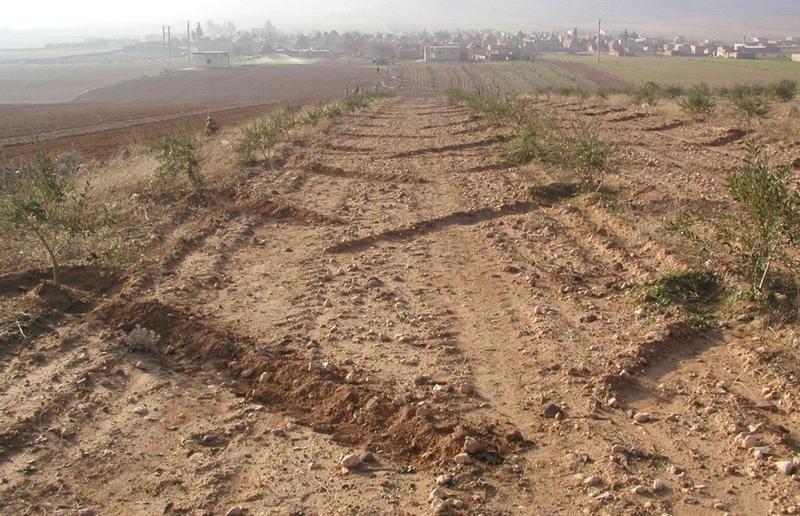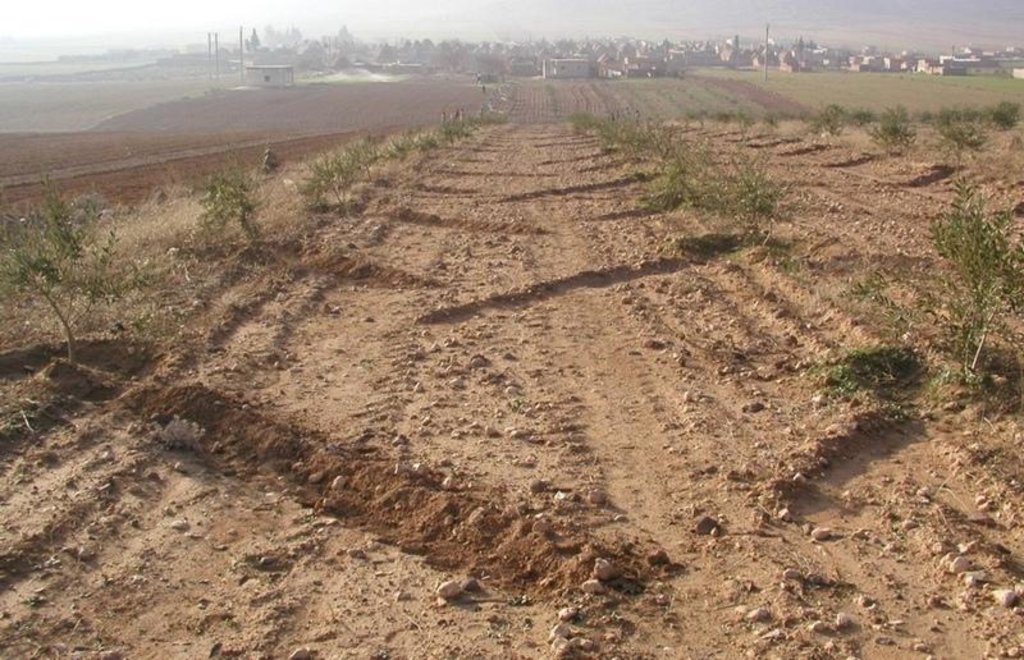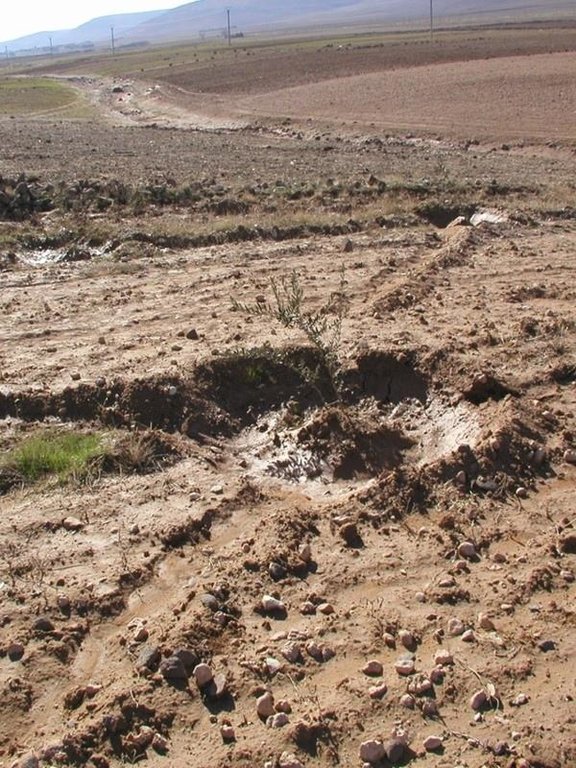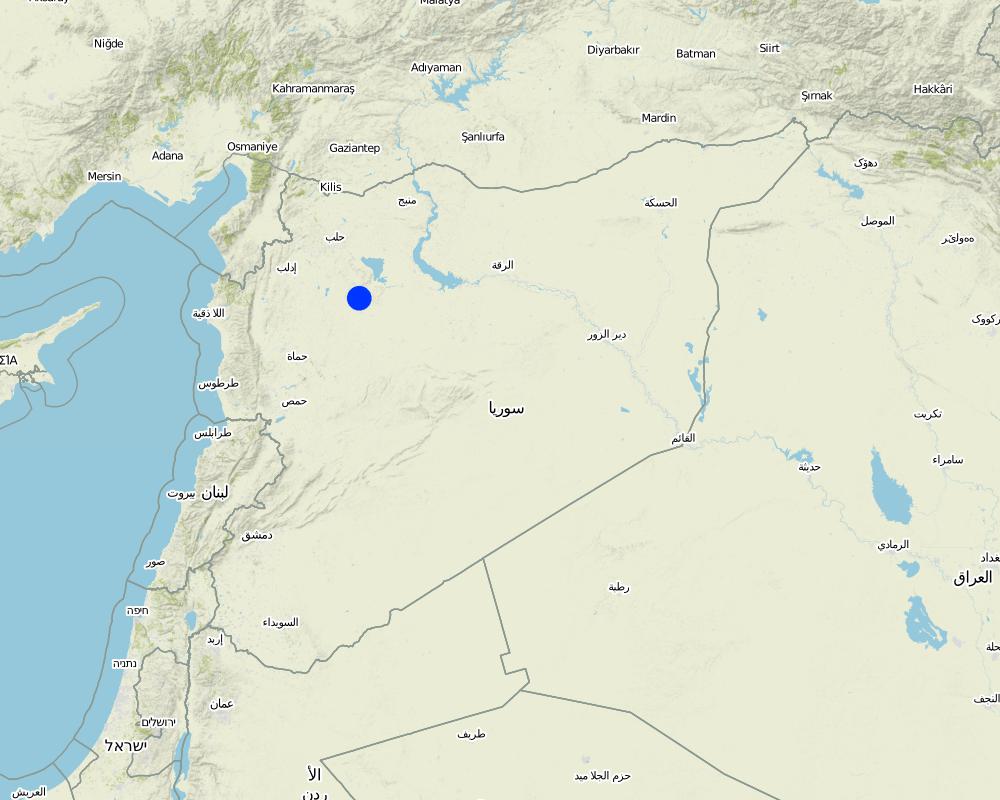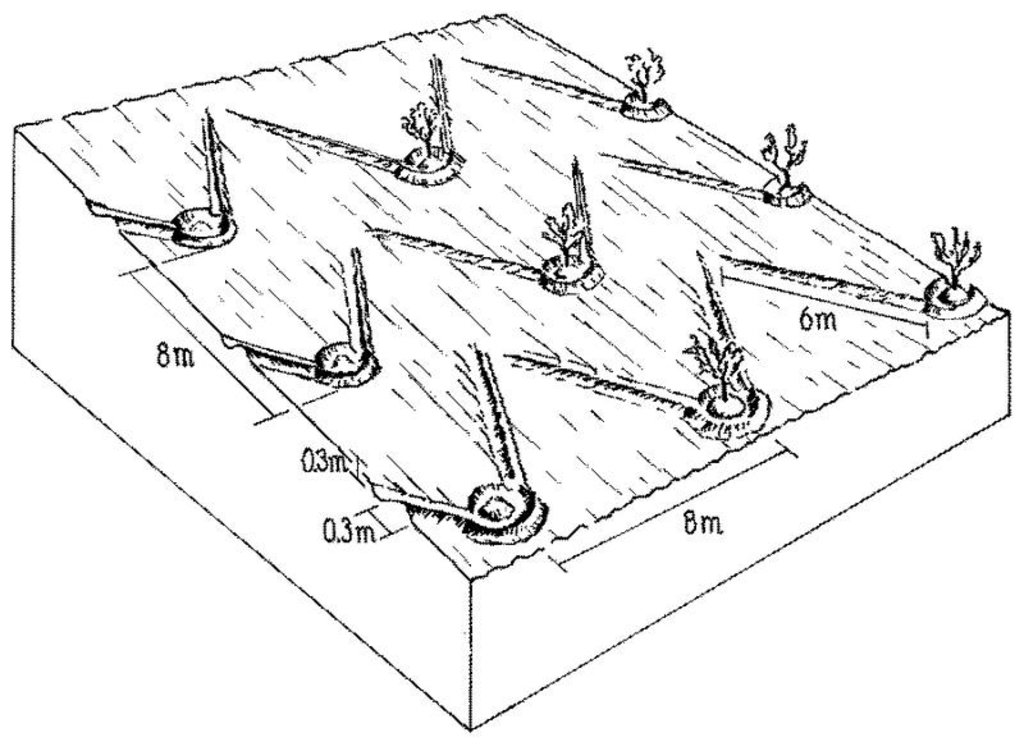Furrow-enhanced runoff harvesting for olives [阿拉伯叙利亚共和国]
- 创建:
- 更新:
- 编制者: Francis Turkelboom
- 编辑者: –
- 审查者: Deborah Niggli, Alexandra Gavilano
technologies_1005 - 阿拉伯叙利亚共和国
查看章节
全部展开 全部收起1. 一般信息
1.2 参与该技术评估和文件编制的资源人员和机构的联系方式
SLM专业人员:
Tubeileh Ashraf
ICARDA
阿拉伯叙利亚共和国
SLM专业人员:
La Rovere Roberto
阿拉伯叙利亚共和国
SLM专业人员:
Burggeman Adriana
阿拉伯叙利亚共和国
有助于对技术进行记录/评估的项目名称(如相关)
Book project: where the land is greener - Case Studies and Analysis of Soil and Water Conservation Initiatives Worldwide (where the land is greener)有助于对技术进行记录/评估的项目名称(如相关)
Book project: Water Harvesting – Guidelines to Good Practice (Water Harvesting)有助于对技术进行记录/评估的机构名称(如相关)
International Center for Agricultural Research in the Dry Areas (ICARDA) - 黎巴嫩1.3 关于使用通过WOCAT记录的数据的条件
编制者和关键资源人员接受有关使用通过WOCAT记录数据的条件。:
是
1.4 所述技术的可持续性声明
这里所描述的技术在土地退化方面是否存在问题,导致无法被认为是一种可持续的土地管理技术?:
否
1.5 参考关于SLM方法(使用WOCAT记录的SLM方法)的调查问卷
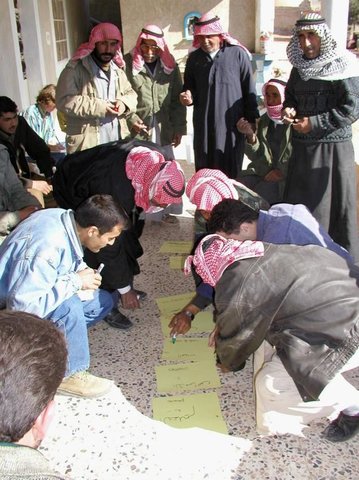
Participatory technology development [阿拉伯叙利亚共和国]
Participatory technology development, through close researcher-farmer interaction, for sustainable land management of olive orchards in dry marginal areas.
- 编制者: Francis Turkelboom
2. SLM技术的说明
2.1 技术简介
技术定义:
Runoff harvesting through annually constructed V-shaped microcatchments, enhanced by downslope ploughing.
2.2 技术的详细说明
说明:
The Khanasser Valley in north-west Syria is a marginal agricultural area, with annual rainfall of about 220 mm/year. Soils are shallow and poor in productivity. The footslopes of degraded hills are traditionally used for extensive grazing or barley cultivation. However to achieve self-sufficiency in olive oil production, several farmers have developed orchards in this area - which is generally considered too dry for olives.
Trees are spaced at 8 m apart, within and between rows. Traditionally, farmers prefer to till their orchards by tractor in order to keep them weed-free (weeds may attract sheep, lead to fires and compete for water with the olive trees). As this tillage operation is usually practised up and down the slope, the resulting furrows stimulate runoff and erosion. However, when this is combined with Vshaped and/or fish-bone shaped microcatchments around individual trees, the furrows created can be used to harvest runoff water for improved production.
The V-shape earthen bunds (reinforced with some stones) are constructed manually, by hoe, around each tree. The furrows then divert runoff systematically to the microcatchments where it concentrates in basins around the trees. Each tree is effectively served by a catchment area of 60 m2. The catchment: cultivated area ratio is thus approximately 60:1 (assuming the area exploited by the tree.
This technology saves irrigation water during the dry season, enhances soil moisture storage, and stimulates olive tree growth. Furthermore, fine particles of eroded soil are captured in the microcatchments. While these may be nutrientrich, they also tend to seal the surface. The bunds need to be rebuilt every year. If the structures are damaged after a heavy storm, they need to be repaired. Labour input for establishment and maintenance is low, the technology is easy and cheap to maintain, and there is enough local skill to sustain and expand the system. A supporting technology is to mulch the area around each tree with locally available stones (limestone and/or basalt) to reduce soil temperature during the summer, decrease surface evaporation and improve infiltration. The catchment areas between the trees are sometimes planted with low water-demanding winter annuals (lentils, vetch, barley, etc) especially when the trees are young. This helps to reduce surface erosion. Implementation of furrow-enhanced runoff water harvesting in olive orchards started in 2002, and adoption by farmers is growing gradually.
2.3 技术照片
2.5 已应用该技术的、本评估所涵盖的国家/地区/地点
国家:
阿拉伯叙利亚共和国
区域/州/省:
Aleppo, NW Syria
有关地点的进一步说明:
Khanasser Valley
注释:
Total area covered by the SLM Technology is 0.05 km2.
Map
×2.7 技术介绍
详细说明该技术是如何引入的:
- 通过项目/外部干预
3. SLM技术的分类
3.1 该技术的主要目的
- 改良生产
- 减少、预防、恢复土地退化
- 创造有益的经济影响
3.2 应用该技术的当前土地利用类型
同一土地单元内混合使用的土地::
是
具体说明混合土地使用(作物/放牧/树木):
- 林牧业

农田
- 一年一作
- 乔木与灌木的种植
年作 - 具体指明作物:
- 谷类 - 大麦
- lentils, vetch
乔木和灌木种植 - 指定作物:
- 橄榄树
每年的生长季节数:
- 1
具体说明:
Longest growing period in days: 150, Longest growing period from month to month: Dec - Apr

牧场

森林/林地
注释:
Major land use problems (compiler’s opinion): There are a series of problems in this area, including: low and erratic rainfall, drought, low land productivity, poor water use efficiency, land degradation, limited ground water for irrigation, few agricultural options, and low income from agriculture.
Semi-nomadism / pastoralism: before SWC
3.3 由于技术的实施,土地使用是否发生了变化?
由于技术的实施,土地使用是否发生了变化?:
- 否(继续问题3.4)
同一土地单元内混合使用的土地::
是
注释:
Semi-nomadism / pastoralism: before SWC
3.4 供水
该技术所应用土地的供水:
- 雨养
3.5 该技术所属的SLM组
- 集水
- 灌溉管理(包括供水、排水)
- 引水和排水
3.6 包含该技术的可持续土地管理措施

农艺措施

结构措施
3.7 该技术强调的主要土地退化类型

土壤水蚀
- Wt:表土流失/地表侵蚀

土壤风蚀
- Et:表土流失

化学性土壤退化
- Cn:肥力下降和有机质含量下降(非侵蚀所致)

水质恶化
- Ha:干旱化
3.8 防止、减少或恢复土地退化
具体数量名该技术与土地退化有关的目标:
- 修复/恢复严重退化的土地
4. 技术规范、实施活动、投入和成本
4.1 该技术的技术图纸
技术规范(与技术图纸相关):
V-shaped micro-catchments which harvest water for the olive trees: the furrows up-and-down slope help channel the runoff to the olives.
Technical knowledge required for field staff / advisors: low
Technical knowledge required for land users: low
Main technical functions: control of dispersed runoff: retain / trap, increase / maintain water stored in soil, water harvesting / increase water supply
Secondary technical functions: reduction of slope length, sediment retention / trapping, sediment harvesting, reduction in wind speed
Agronomic measure: up and down tillage
Remarks: (for runoff collection)
Structural measure: V-shaped bunds
Structural measure: mulching with stones (supportive, see also 2.8)
Construction material (stone): limestone, basalt (locally available)
作者:
Mats Gurtner
4.3 技术建立活动
| 活动 | 时间(季度) | |
|---|---|---|
| 1. | Up-and-down tillage by tractor driven plough | in winter |
| 2. | Construction of runoff harvesting bunds and micro-basins, manually by hoe | November/December; beginning of rainy season |
| 3. | V-shaped bunds are seasonal structures and thus established every year. Construction of runoff harvesting bunds and micro-basins |
4.4 技术建立所需要的费用和投入
| 对投入进行具体说明 | 单位 | 数量 | 单位成本 | 每项投入的总成本 | 土地使用者承担的成本% | |
|---|---|---|---|---|---|---|
| 劳动力 | Construction (10 person days) | ha | 1.0 | 50.0 | 50.0 | 100.0 |
| 设备 | Machine use | ha | 1.0 | 10.0 | 10.0 | 100.0 |
| 设备 | Tools | ha | 1.0 | 3.0 | 3.0 | 100.0 |
| 技术建立所需总成本 | 63.0 | |||||
| 技术建立总成本,美元 | 63.0 | |||||
4.5 维护/经常性活动
| 活动 | 时间/频率 | |
|---|---|---|
| 1. | Maintenance of bunds in winter/rainy season | after heavy rainfall 1-3 times a year |
4.6 维护/经常性活动所需要的费用和投入(每年)
| 对投入进行具体说明 | 单位 | 数量 | 单位成本 | 每项投入的总成本 | 土地使用者承担的成本% | |
|---|---|---|---|---|---|---|
| 劳动力 | Repair (5 person days) | ha | 1.0 | 25.0 | 25.0 | 100.0 |
| 技术维护所需总成本 | 25.0 | |||||
| 技术维护总成本,美元 | 25.0 | |||||
注释:
Machinery/ tools: tractor, hoe, tractor-driven plough
The calculation covers the runoff harvesting technology alone - annual activities of ploughing and water harvesting structure establishment and maintenance. Planting of olive trees and their maintenance are not included here.
5. 自然和人文环境
5.1 气候
年降雨量
- < 250毫米
- 251-500毫米
- 501-750毫米
- 751-1,000毫米
- 1,001-1,500毫米
- 1,501-2,000毫米
- 2,001-3,000毫米
- 3,001-4,000毫米
- > 4,000毫米
农业气候带
- 半干旱
5.2 地形
平均坡度:
- 水平(0-2%)
- 缓降(3-5%)
- 平缓(6-10%)
- 滚坡(11-15%)
- 崎岖(16-30%)
- 陡峭(31-60%)
- 非常陡峭(>60%)
地形:
- 高原/平原
- 山脊
- 山坡
- 山地斜坡
- 麓坡
- 谷底
垂直分布带:
- 0-100 m a.s.l.
- 101-500 m a.s.l.
- 501-1,000 m a.s.l.
- 1,001-1,500 m a.s.l.
- 1,501-2,000 m a.s.l.
- 2,001-2,500 m a.s.l.
- 2,501-3,000 m a.s.l.
- 3,001-4,000 m a.s.l.
- > 4,000 m a.s.l.
关于地形的注释和进一步规范:
Slopes on average: Also rolling (ranked 2) and gentle (ranked 3)
5.3 土壤
平均土层深度:
- 非常浅(0-20厘米)
- 浅(21-50厘米)
- 中等深度(51-80厘米)
- 深(81-120厘米)
- 非常深(> 120厘米)
土壤质地(表土):
- 中粒(壤土、粉土)
表土有机质:
- 低(<1%)
如有可能,附上完整的土壤描述或具体说明可用的信息,例如土壤类型、土壤酸碱度、阳离子交换能力、氮、盐度等。:
Soil depth on average: Also shallow (ranked 2) and deep (ranked 3)
Soil fertility: Low (ranked 1) and very low (ranked 2)
Soil drainage/infiltration: Good (ranked 1) and medium (ranked 2)
5.6 应用该技术的土地使用者的特征
生产系统的市场定位:
- 混合(生计/商业)
非农收入:
- 收入的10-50%
说明土地使用者的其他有关特征:
Off-farm income specification: from farm labour and non-agricultural activities in nearby cities
5.7 应用该技术的土地使用者使用的平均土地面积
- < 0.5 公顷
- 0.5-1 公顷
- 1-2 公顷
- 2-5公顷
- 5-15公顷
- 15-50公顷
- 50-100公顷
- 100-500公顷
- 500-1,000公顷
- 1,000-10,000公顷
- > 10,000公顷
注释:
Average area of land owned or leased by land users applying the Technology: Also 5-15 ha (ranked 3)
5.8 土地所有权、土地使用权和水使用权
- individual
土地使用权:
- 个人
6. 影响和结论性说明
6.1 该技术的现场影响
社会经济效应
生产
作物生产
土地管理
水资源可用性和质量
灌溉用水的可用性
注释/具体说明:
Through water saving
收入和成本
工作量
其它社会经济效应
Tree growth
Dependency on tractor
社会文化影响
SLM/土地退化知识
Landscape and environmental quality
生态影响
水循环/径流
地表径流
土壤
土壤水分
土壤流失
养分循环/补给
注释/具体说明:
Increase in soil fertility
生物多样性:植被、动物
植物多样性
动物多样性
栖息地多样性
害虫/疾病控制
注释/具体说明:
Increased weed growth around trees
减少气候和灾害风险
风速
6.2 该技术的场外影响已经显现
下游洪水
下游淤积
6.4 成本效益分析
技术收益与技术维护成本/经常性成本相比如何(从土地使用者的角度看)?
短期回报:
积极
6.5 技术采用
在所有采用这项技术的人当中,有多少人是自发的,即未获得任何物质奖励/付款?:
- 91-100%
注释:
100% of land user families have adopted the Technology without any external material support. There is a little trend towards spontaneous adoption of the Technology. Generally moderate adoption: Mainly applied by ‘agriculturalists’, that is households whose livelihoods mainly depend on agriculture. Farmers with more interest in off-farm labour or sheep rearing - less interested. Is expanding slowly but gradually.
6.7 该技术的优点/长处/机会
| 编制者或其他关键资源人员认为的长处/优势/机会 |
|---|
| Increases soil moisture storage in low rainfall areas and allows expansion of olive plantation into drier areas |
| Easy, low-cost and requires no extra external inputs. |
| Reduces soil erosion. |
| Reduces summer irrigation needs |
| Improves olive productivity |
6.8 技术的弱点/缺点/风险及其克服方法
| 编制者或其他关键资源人员认为的弱点/缺点/风险 | 如何克服它们? |
|---|---|
| Extra labour needed | Construct during off-season. |
| Increases weed growth in the tree basin | More stone mulching. |
| Trees will still need some irrigation in summer | Make irrigation practices more efficient. |
7. 参考和链接
7.1 信息的方法/来源
- 实地考察、实地调查
- 与土地使用者的访谈
(现场)数据是什么时候汇编的?:
01/11/2004
7.2 参考可用出版物
标题、作者、年份、ISBN:
Tubeileh A and Turkelboom F, Participatory research on water and soil management with olive growers in the KhanasserValley. KVIRS project, ICARDA, Aleppo, Syria. 2004.
标题、作者、年份、ISBN:
Tubeileh A, Bruggeman A and Turkelboom F, Growing olive and other tree species in marginaldry environments. ICARDA, Aleppo, Syria. 2004.
链接和模块
全部展开 全部收起链接

Participatory technology development [阿拉伯叙利亚共和国]
Participatory technology development, through close researcher-farmer interaction, for sustainable land management of olive orchards in dry marginal areas.
- 编制者: Francis Turkelboom
模块
无模块


